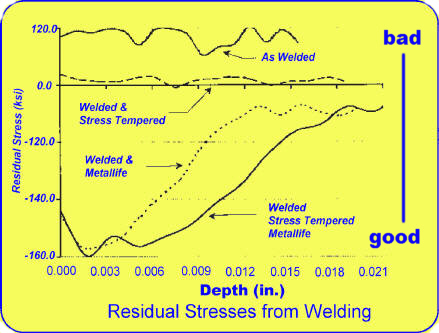
It is achieved by heating part (commonly called local heat treatment) or all of the component to a suitable temperature. This is held for a pre-determined time, then the temperature is slowly reduced. Stress relieving is a process that does not harden the material. Heat treatment procedures may be applied to relieve stresses induced by welding, casting, normalising, quenching, machining and cold working. Stresses that are introduced into metals by manufacturing and welding procedures may cause harmful distortion, fractures, and corrosion cracking near welds. Stress relieving is widely used in the oil & gas and mining industries during maintenance procedures.

Metals 101-4 What is Stress
The treatment consists in heating up metal items at a temperature at which steel has a very low yield strength (it is red).
 At soaking temperature, residual stresses reduce themselves until they have no significant effects anymore, through flowing of viscous material. In case more performing materials are chosen than normal carbon steel for construction, particular consideration should be given to the temperature to be adopted during stress relieving, since mechanical characteristics in quenched and tempered steel, alloy steel and low-alloy steel are conveyed through the classical hardening treatments (hardened and tempered steels), normalizing (alloy steels and low alloying steels) and followed by tempering.
At soaking temperature, residual stresses reduce themselves until they have no significant effects anymore, through flowing of viscous material. In case more performing materials are chosen than normal carbon steel for construction, particular consideration should be given to the temperature to be adopted during stress relieving, since mechanical characteristics in quenched and tempered steel, alloy steel and low-alloy steel are conveyed through the classical hardening treatments (hardened and tempered steels), normalizing (alloy steels and low alloying steels) and followed by tempering.
On-site stress relieving services, lp. Is a specialty industrial heat treating company offering portable on-site services to oil & gas processing facilities, refinery and petrochemical plants, power generation plants, fabricating companies, manufacturing companies, and off shore equipment companies. Osr specializes in on-site post weld heat treating (pwht) of pressure vessels, welded structures, field fabrications and piping using portable electrical heating and combustion heat treating equipment. Services are provided for both new construction and turnaround projects.
Another heat treat process for steel is stress relieving. As the title suggests, it reduces the residual stresses that may have been caused by hot rolling, welding, or cutting. With this process, the steel is heated to a temperature below the critical temperature, resulting in little to no change to the material properties like there is with annealing and normalizing. This is typically used on lower carbon materials, such as a36. These are all processes that prepare steel for further processing. They allow
for an easier time in machining, forming, and help minimize distortion while being worked. If you have further questions about the annealing, normalizing, or stress relieving processes and how they may be beneficial to what you’re looking for, please contact a specialist with clifton steel.